The Talking Phrasebook Series presents useful phrases and words in side-by-side translation and with audio files specifically geared to help students work on listening skills and pronunciation. Below, you will find several useful phrases and words. To the left is the English and to the above right is an English transliteration of the Armenian translation. Below the English transliteration is the original Armenian in Armenian script.
The center column for each row presents a play button. The recorded file will feature first English, then the Armenian in three versions: one slow, one with each syllable broken out, and a last version that will be spoken as it might be overheard in a conversation between native speakers.
10 Facts About Armenian
Speakers: Armenian is spoken by about 6 to 7 million people worldwide, with around 3 million speakers in the Republic of Armenia. Large diaspora communities also speak Armenian in countries like Russia, the United States, France, Iran, Lebanon, and Georgia.
Status: Armenian is a unique branch of the Indo-European language family. Though it shares roots with languages like Greek and Sanskrit, it developed distinct phonology, morphology, and vocabulary, making it mutually unintelligible with any other Indo-European language.
Dialects: Armenian has two dialects. Eastern Armenian is primarily spoken in Armenia, Iran, and former Soviet countries. Western Armenian is spoken by diaspora communities, especially in Lebanon, Turkey, and the U.S. They differ significantly in pronunciation, vocabulary, grammar, and even some verb conjugations, to the point of posing communication challenges between speakers of the two.
Gender: Armenian does not have grammatical gender. Nouns, adjectives, and pronouns do not change based on gender, and there is no equivalent to “he” or “she”—both are simply նա (na). This makes the language gender-neutral by default, a rarity among Indo-European languages.
Cases: Armenian grammar uses seven cases for nouns, pronouns, and adjectives. These cases are nominative, accusative, genitive, dative, ablative, instrumental, and locative. Ablative indicates separation, cause, or comparison.
Respect: Armenian expresses respect through the use of a plural you: դուք (duk’) (plural “you”). This is used even when speaking to one person, similar to French vous, when the person is older or of a higher status. Armenian also uses honorifics like պարոն (paron, “Mr.”) and տիկին (tikin, “Mrs.”).
Alphabet: The Armenian alphabet is used only for Armenian. Created in 405 CE by Mesrop Mashtots, a monk, linguist, and theologian, the alphabet currently contains 39 letters (originally 36), and is completely unique, not derived from Latin, Greek, Arabic, or Cyrillic scripts. It was designed to give Armenian a distinct cultural identity and remains a national symbol.
Punctuation: Armenian also uses its own punctuation system. All sentences end with a colon (։), which is called “verjaket” in Armenian. Questions will include a hartsakan nshan, a small curl in the upper space that look like this: ՞ . This symbol is placed above the stressed word in the sentence. Similarly, exclamatory sentences will have a ՜, called a shesht, placed above the stressed word or syllable.
Examples:
- Ի՜նչ լավ օր է։ (What a beautiful day!)
- Նա քեզի՞ տեսավ։ (Did he see you?)
Verbs: Conjugation in Armenian is changes based on tense, aspect, mood, person, and number. There are complex systems for present, imperfect, future, conditional, aorist, subjunctive, and imperative moods. Aorist is an unqualified past tense that makes no mention of completion or duration of the action.
Classical Armenian: Used from the 5th century until the 19th century, classical Armenian, known as Grabar (Գրաբար), is now a “dead language,” like Latin. Classical Armenian was effectively frozen in the 5th century and remained unchanged, used in religious texts, scholarship, official documents, and high literature for centuries. Meanwhile, vernacular Armenian changed considerably, passing through Middle Armenian (1100 – 1600s), to the modern dialects of today. By the 19th century, Grabar was unintelligible to most Armenians (much like Old English is unintelligble to modern English speakers). To promote literacy, Eastern Armenian was simplified, standardized, and made official in 1920 when the Soviets came to power in Armenia. Western Armenian has also been simplified and standardized, but did so via decentralized, grassroots efforts. This is one reason why the two dialects are different. Grabar still plays a vital role in Armenian Church services, liturgical texts, and some high literary traditions. Modern Armenian speakers often study Grabar to read older manuscripts or understand religious services.
Armenian Alphabet Table (Eastern Armenian)
| Letter | Name | Pronunciation (IPA) | English Sound Examples |
|---|---|---|---|
| Ա ա | Ayb | /ɑ/ | a in father, car |
| Բ բ | Ben | /b/ | b in boy, bubble |
| Գ գ | Gim | /ɡ/ | g in go, game |
| Դ դ | Da | /d/ | d in dog, ride |
| Ե ե | Yeč | /jɛ/ or /ɛ/ | ye in yes, e in egg |
| Զ զ | Za | /z/ | z in zebra, buzz |
| Է է | Ē | /ɛ/ | e in bed, set |
| Ը ը | Ət | /ə/ | a in about, sofa |
| Թ թ | To | /tʰ/ | t in top (with puff of air) |
| Ժ ժ | Zhe | /ʒ/ | s in measure, vision |
| Ի ի | Ini | /i/ | ee in see, machine |
| Լ լ | Liwn | /l/ | l in light, clean |
| Խ խ | Khe | /χ/ | Like ch in loch (Scots), Bach (German) |
| Ծ ծ | Ca | /ts/ | ts in cats, sits |
| Կ կ | Ken | /k/ | k in kite, back |
| Հ հ | Ho | /h/ | h in hat, hello |
| Ձ ձ | Ja | /dz/ | dz in adze, kids |
| Ղ ղ | Ghad | /ʁ/ | French r in rouge; gargled “r” |
| Ճ ճ | Ča | /tʃ/ | ch in check, march |
| Մ մ | Men | /m/ | m in man, smile |
| Յ յ | Hi | /j/ | y in yes, yoga |
| Ն ն | Now | /n/ | n in net, money |
| Շ շ | Sha | /ʃ/ | sh in she, wish |
| Ո ո | Vo | /vo/ or /o/ | vo in vote, o in so |
| Չ չ | Čʿa | /tʃʰ/ | ch in chop (strong puff) |
| Պ պ | Pe | /p/ | p in pet, stop |
| Ջ ջ | Jhe | /dʒ/ | j in jump, ge in edge |
| Ռ ռ | Ra | /r/ (trilled) | Trilled r (like Spanish perro) |
| Ս ս | Se | /s/ | s in sun, sit |
| Վ վ | Vew | /v/ | v in van, never |
| Տ տ | Tiwn | /t/ | t in time, stop |
| Ր ր | Re | /ɾ/ (tapped r) | Tapped r like Spanish pero |
| Ց ց | Co | /t͡sʰ/ | ts in cats (with puff) |
| Ւ ւ | Hiwn | /v/ (historical) | Part of digraphs (e.g., ու /u/), not used independently |
| Փ փ | Pʿiwr | /pʰ/ | p in pot (aspirated) |
| Ք ք | Kʿe | /kʰ/ | k in kick (aspirated) |
| Օ օ | Ō | /o/ | o in bone, go |
| Ֆ ֆ | Fe | /f/ | f in fan, coffee |
Survival Basics for Armenian
| Hello! | Barev! (Բարև:) *informal, conversational – to greet a friend |
|
| Hello! | Barev dzez! (Բարև ձեզ:) *more formal – to greet a teacher/passer-by/group of people |
|
| Yes | Ayo ( Այո ՛) |
|
| No | Voch (Ո ՛չ) |
|
| Good morning! | Bari aravot! (Բարի առավոտ:) |
|
| Good afternoon! | Bari or! (Բարի օր:) |
|
| Good evening! | Bari ereko! (Բարի երեկո:) |
|
| What’s up? | Inchpes en gortserd? (Ինչպե՞ս են գործերդ:) |
|
| What’s up? | Inch ka chka?
(Ի՞նչ կա չկա:) |
|
| How are you? | Inchpes es? (sing.) (Ինչպե՞ս ես:) |
|
| Good, thanks, and you? | Lav, shnorhakalutyun, isk du? (Լավ, շնորհակալություն, իսկ դու՞:) |
|
| Good bye! | Hajogh! (Հաջող:) *infomal, conversational |
|
| Good bye! | Tstesutyun! (Ցտեսություն:) *more formal |
|
| See you later! | Ktesnvenk. (Կտեսնվենք:) |
|
| Sorry! | Kneres!
(Կներե ՛ս:) |
|
| Open/closed | Bats e/pak e (Բաց է/փակ է) |
|
| Pull/push | Depi ners/depi durs (Դեպի ներս/դեպի դուրս) *when referring to a door |
|
| Small/big | Pokr/mets (Փոքր/մեծ) |
|
| Do you speak English? | Duq khosum ek angleren? (Դուք խոսու՞մ եք անգլերեն:) |
|
| I don’t speak English. | Es chem khosum angleren. (Ես չեմ խոսում անգլերեն:) |
|
| I only speak a little Armenian. | Es mi poqr khosum em hayeren. (Ես մի փոքր խոսում եմ հայերեն:) |
|
| I understand. | Es haskanum em.
(Ես հասկանում եմ:) |
|
| I don’t understand. | Es chem haskanum. (Ես չեմ հասկանում:) |
|
| Thank you! | Shnorhakalutyun. (Շնորհակալություն:) |
|
| Thank you very much! | Shat shnorhakalutyun.
(Շատ շնորհակալություն:) |
|
| Very well, thanks! | Shat lav, shnorhakalutyun. (Շատ լավ, շնորհակալություն:) |
|
| Well/Good | Lav (Լավ) |
|
| Poor/Bad | Vat (Վատ) |
|
| Please | Khndrum em. (Խնդրում եմ:) *When asking for something politely |
|
| You’re welcome! | Khdrem! (Խնդրե՛մ:) *when responding to “Спасибо!” |
|
| You’re welcome! | Сharzh e. (Չարժ է:) *More informal |
|
| Excuse me! | Neretsek!
(Ներեցե՛ք:) |
|
| A little | Mi pokr
(Մի փոքր) |
|
| Could you speak more slowly? | Karogh ek mi poqr dandakh khosel? (Կարո՞ղ եք մի փոքր դանդաղ խոսել:) |
|
| Could you repeat, please? | Krknek khndrum em!
(Կրկնե՛ք, խնդրում եմ:) |
|
| Could you write that down? | Karogh ek sa grel? (Կարո՞ղ եք սա գրել:) |
|
| I would like to make an appointment. | Es kuzeyi grantsvel aytsi. (Ես կուզեի գրանցվել այցի:) |
|
| My passport was stolen. | Im andznagiry goghatsel en. (Իմ աձնագիրը գողացել են:) |
|
| My bag was stolen. | Im payusaky goghatsel en. (Իմ պայուսակը գողացել են:) |
|
| My wallet was stolen. | Im dramapanaky goghatsel en. (Իմ դրամապանակը գողացել են:) |
|
| I need a doctor! | Es petq e gnam bzhshki. (Ես պետք է գնամ բժշկի:) |
|
| Call the police! | Vostikanutyun kanchek. (Ոստիկանություն կանչե՛ք:) |
Introductions in Armenian
| What is your name? | Inchpes e ko anuny? (Ինչպե՞ս է քո անունը:) |
|
| Pleased to meet you! | Hacheli e tsanotanal! (Հաճելի է ծանոթանալ:) Armenians may also say simply “Հաճելի է”(meaning “it’s nice”) |
|
| It’s mutual. | Pokhadardzabar.
(Փոխադարձաբար:) (In response to “pleased to meet you;” Literally means “similarly”) |
|
| I am 25 years old. | Es ksanhing tarekan em. (Ես քսանհինգ տարեկան եմ:) |
|
| How old are you? | Kani tarekan es? (Քանի՞ տարեկան ես:) |
|
| Where are you from? | Vorteghits es? (Որտեղի՞ց ես:) |
|
| I am American. | Es Amerikatsi em. (Ես Ամերիկացի եմ:) |
|
| No, I am from Canada. | Voch, es Kanadayits em. (Ո ՛չ, ես Կանադայից եմ:) |
|
| She is Australian. | Na avstralitsi e. (Նա ավստրալիացի է:) |
|
| He is Irish. | Na irlandatsi e. (Նա իռլանդացի է:) |
|
| We are from New Zealand. | Menk Nor Zelandiayits enk. (Մենք Նոր Զելանդիայից ենք:) |
|
| They are from Wales. | Nrank Uelsits en. (Նրանք Ուելսից են:) |
|
| How do you like Armenia? | Kez dur e galis Hayastanum? (Քեզ դու՞ր է գալիս Հայաստանում։) |
|
| I like Armenia very much. | Indz shat e dur galis Hayastanum.
(Ինձ շատ է դուր գալիս Հայաստանում:) |
|
| Have you ever been to Gyumri? | Duk erbevits e eghel ek Gyumriyum? (Դուք երբևիցե եղե՞լ եք Գյումրիում։) |
|
| I have never been to Goris before. | Es erbek chem eghel Gorisum. (Ես երբեք չեմ եղել Գորիսում։) |
|
| This is my second time in Armenia. | Es arden erkrord angam em Hayastanum. (Ես արդեն երկրորդ անգամ եմ Հայաստանում:) |
|
| What do you do? | Inchov es zbaghvum? (Ինչո՞վ ես զբաղվում։) |
|
| I am a doctor | Es bzhishk em. (Ես բժիշկ եմ։) |
|
| I am a teacher | Es usutsich em. (Ես ուսուցիչ եմ:) |
|
| I am a businessman | Es biznesmen em. (Ես բիզնեսմեն եմ:) |
|
| I am a student. | Es usanogh em. (Ես ուսանող եմ:) |
|
| I am on vacation. | Es ardzakurdum em. (Ես արձակուրդում եմ:) *If you’re working |
|
| I am on vacation. | Es ardzakurdum em. (Ես արձակուրդում եմ:) *If you are a student on break |
|
| I am here on business. | Es aystegh gortsov em. (Ես այստեղ գործով եմ:) |
|
| I am studying here. | Es aystegh sovorum em.
(Ես այստեղ սովորում եմ:) |
Asking Directions
| Where are the toilets? | Vortegh e aystegh zugarany? (Որտե՞ղ է այստեղ զուգարանը:) |
|
| Men’s | Tghamardkants (տղամարդկանց) |
|
| Women’s | Kanants (Կանանց) |
|
| Where is the nearest bank? | Vortegh e aystegh motaka banky? (Որտե՞ղ է այստեղ մոտակա բանկը:) |
|
| Where is the nearest post office? | Vortekh e aystegh motaka posti masnachyughy? (Որտե՞ղ է այստեղ մոտակա փոստի մասնաճյուղը:) |
|
| Where is the nearest train station? | Vortekh e aystegh motaka kayarany? (Որտե՞ղ է այստեղ մոտակա կայարանը:) |
|
| Where can I find Wi-Fi? | Chgitek vortekh e aystekghWi-Fiy? (Չգիտե՞ք որտեղ է այստեղ Wi-FI:) |
|
| Do you know the Wi-Fi password? | Chgitek Wi-Fiyi gaghtnabary? ( Չգիտե՞ք Wi-Fi գաղտնաբառը:(Gen. can be used colloquially) |
|
| How can I order a taxi? | Inchpes karogh em taxi patvirel? (Ինչպե՞ս կարող եմ տաքսի պատվիրել:) |
|
| Straight ahead! | Ughigh gnatsek! (Ուղիղ գնացե ՛ք:) |
|
| Take a right! | Pttvek aj! (Պտտվե ՛ք աջ:) |
|
| Take a left! | Pttvek dzakh! (Պտտվե ՛ք ձախ:) |
|
| After the stoplight | Lusatsuytsits heto Լուսացույցից հետո |
|
| Next/First/Last | Hajordy (Հաջորդը) Arajin (Առաջին) Verjin (Վերջին) |
Shopping
| How much does that cost? | Inch arzhe sa? (Ի՞նչ արժե սա:) |
|
| The menu, please! | Khndrum em berek chashatsanky! (Խնդրում եմ բերե ՛ք ճաշացանկը:) |
|
| I’d like a beer, please. | Es ktsankanayi patvirel garejur. (Ես կցանկանայի պատվիրել գարեջուր:) |
|
| I’d like the bill, please. | Kberek hashivy, khndrum em! (Կբերե ՛ք հաշիվը խնդրում եմ:) |
|
| Do you accept credit cards? | Duk yndunum ek dramakan karter? (Դուք ընդունու՞մ եք դրամական քարտեր:) |
Counting in Armenian
| 0 | zro (զրո) |
|
| 1 | mek (մեկ) |
|
| 2 | erku (երկու) |
|
| 3 | erek (երեք) |
|
| 4 | chors (չորս) |
|
| 5 | hing (հինգ) |
|
| 6 | vets (վեց) |
|
| 7 | yot
(յոթ) |
|
| 8 | ut (ութ) |
|
| 9 | inny (իննը) |
|
| 10 | tasy (տասը) |
|
| 11 | tasnymek (տասնմեկ) |
|
| 12 | tasnyerku (տասներկու) |
|
| 13 | tasnyerek (տասներեք) |
|
| 14 | tasnychors (տասնչորս) |
|
| 15 | tasnyhing (տասնհինգ) |
|
| 16 | tasnyvets (տասնվեց) |
|
| 17 | tasnyyot (տասնյոթ) |
|
| 18 | tasnut (տասնութ) |
|
| 19 | tasnyinny
(տասնիննը) |
|
| 20 | ksan (քսան) |
|
| 21 | ksan mek (քսան մեկ) |
|
| 22 | ksan erku (քսան երկու) |
|
| 30 | yeresun’ (երեսուն) |
|
| 40 | karasun
(քառասուն) |
|
| 50 | hisun (հիսուն) |
|
| 60 | vatsun (վաթսուն) |
|
| 70 | yotanasun (յոթանասուն) |
|
| 80 | utsun (ութսուն) |
|
| 90 | innysun
(իննսուն) |
|
| 100 | haryur (հարյուր) |
|
| 111 | haryur tasnymek (հարյուր տասնմեկ) |
|
| 125 | haryur ksan hing (հարյուր քսան հինգ ) |
|
| 200 | erkuharyur
(երկուհարյուր) |
|
| 300 | erekharyur (երեքհարյուր) |
|
| 400 | chorsharyur (չորսհարյուր) |
|
| 500 | hingharyur (հինգհարյուր) |
|
| 600 | vetsharyur (վեցհարյուր) |
|
| 700 | yotharyur (յոթհարույուր) |
|
| 800 | utharyur (ութհարյուր) |
|
| 900 | innyharyur (իննըհարյուր) |
|
| 1000 | hazar (հազար) |
More About the Armenians

Armenia’s Story of Identity: Heroes, Memory, and Meaning
What shapes Armenian national identity? The answer is complex and personal, but one key element is the Armenian national narrative. This includes the heroes and pivotal events taught in schools, the places central to the nation’s collective memory, and the language and beliefs that frame its worldview. A national narrative goes beyond history: it is […]
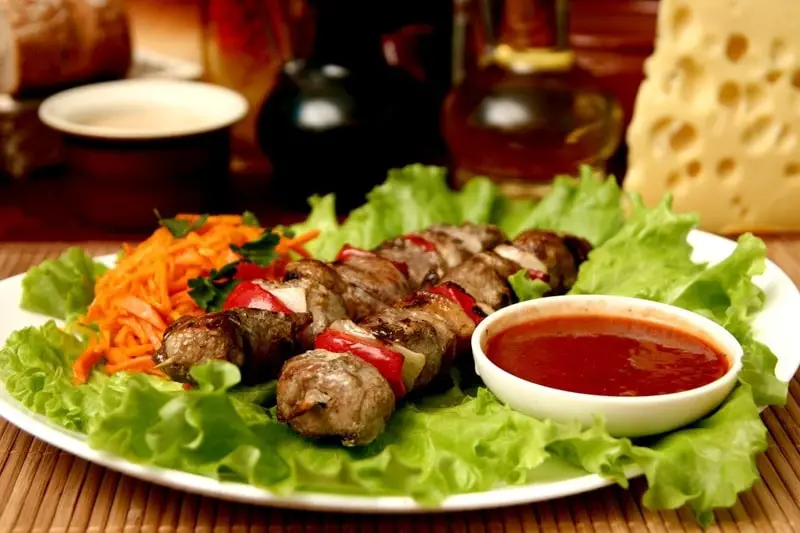
All About Shashlyk (BBQ from the Caucasus)
Shashlyk (шашлык) is considered to be one of the very first dishes humans invented and most likely hails from the place the first modern human likely appeared – the area covering Iran, Iraq, Lebanon, and the Caucasus. How “Shashlyk” Got Its Name (Почему он так называется?) The word “шашлык” was adopted into Russian in the […]
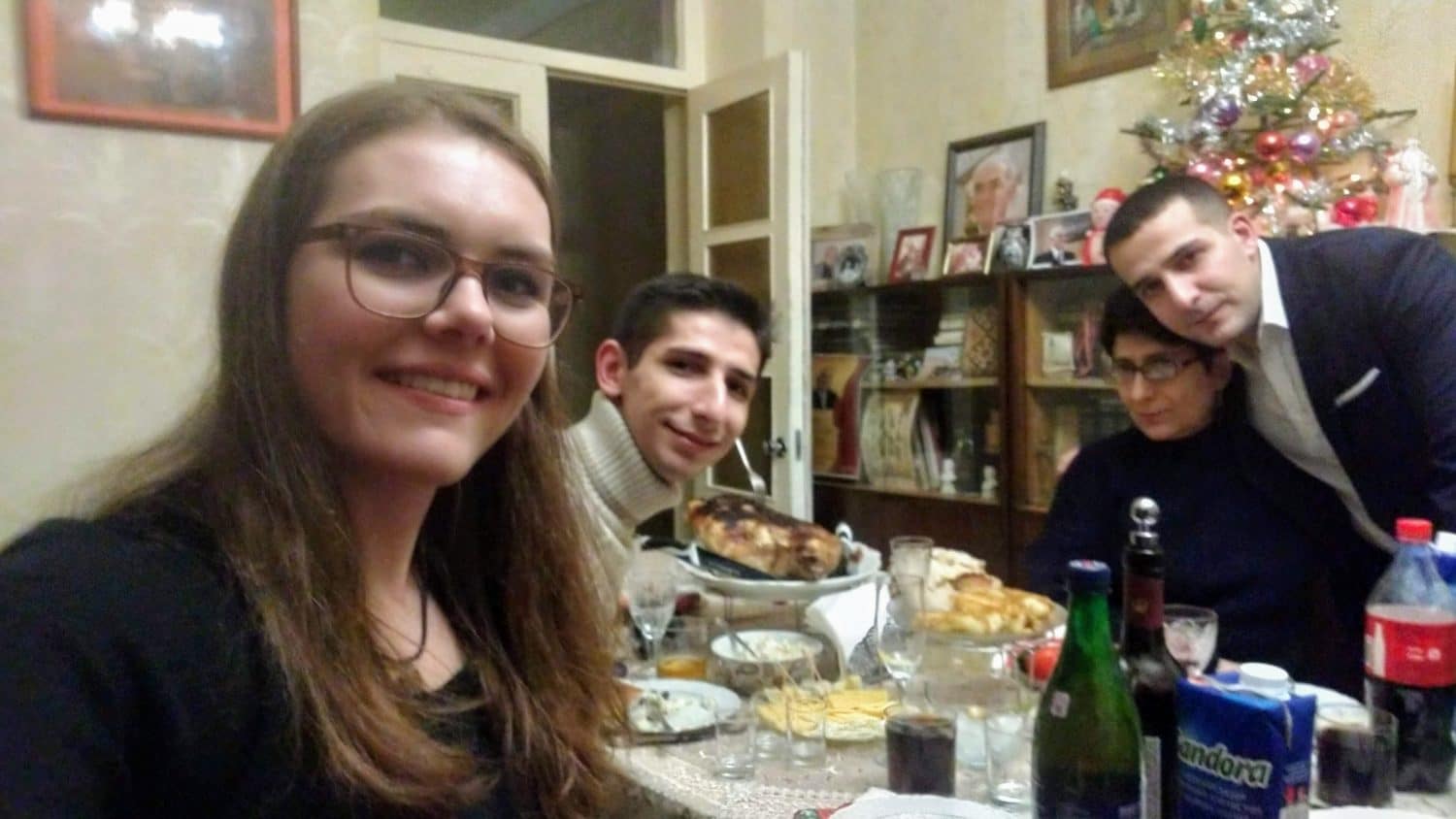
How Armenians Celebrate New Year’s
Studying in Bishkek for the academic year, I took advantage of winter break to visit my host family in Armenia from a previous study abroad experience. This gave me my first opportunity to see how New Year’s is celebrated in this part of the world: the setting up of the New Year’s tree and other […]
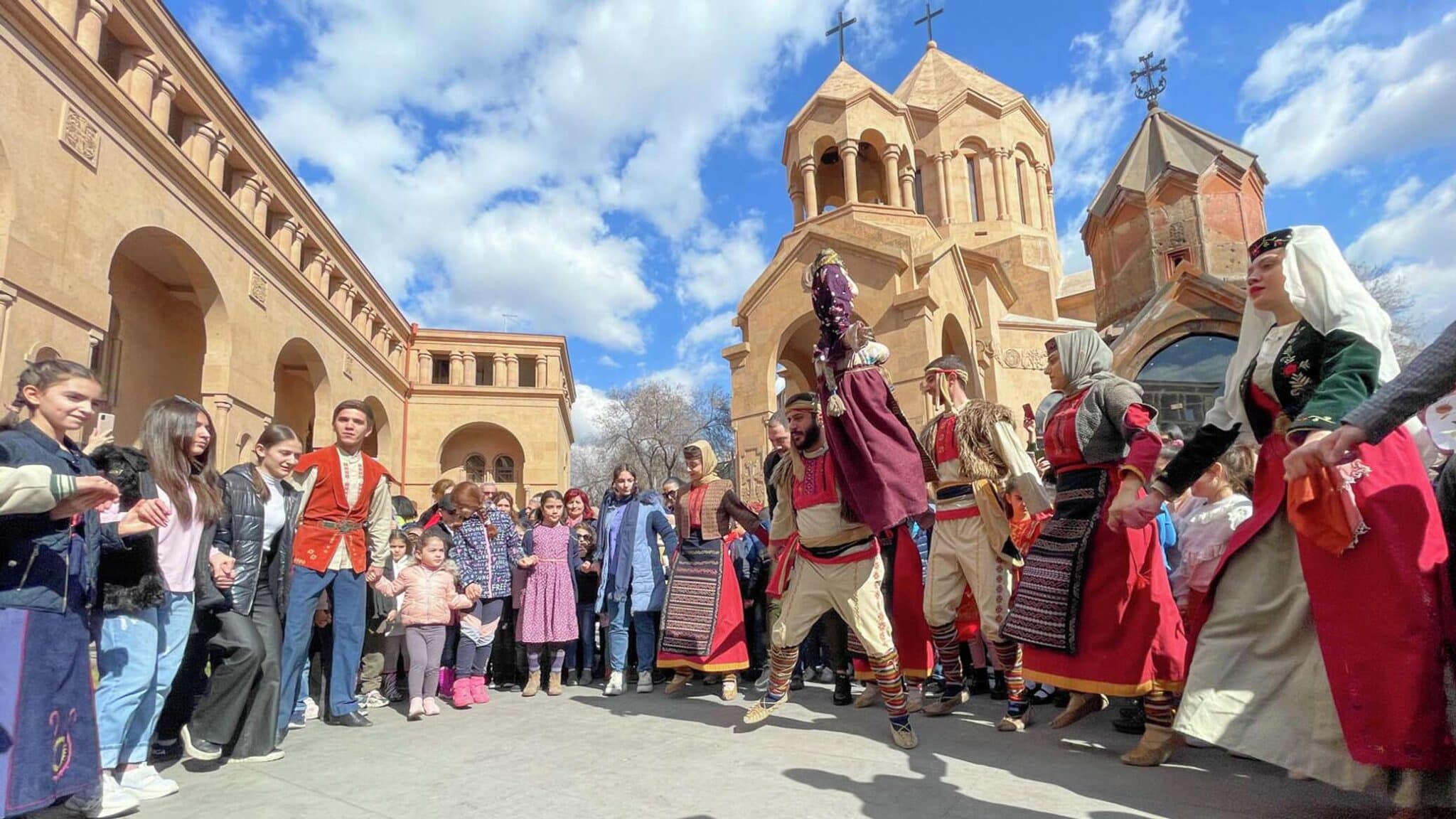
Armenian Holidays 2025: A Complete Guide
Through these holidays, you will find Armenia is filled with a rich history revolving around nationhood, family, and religious tradition. Many holidays are particularly associated with specific monuments emphasizing the importance of place in Armenian culture. Some are ancient holidays steeped in pagan symbolism, officially repressed under the Soviets, but now newly embraced by the […]
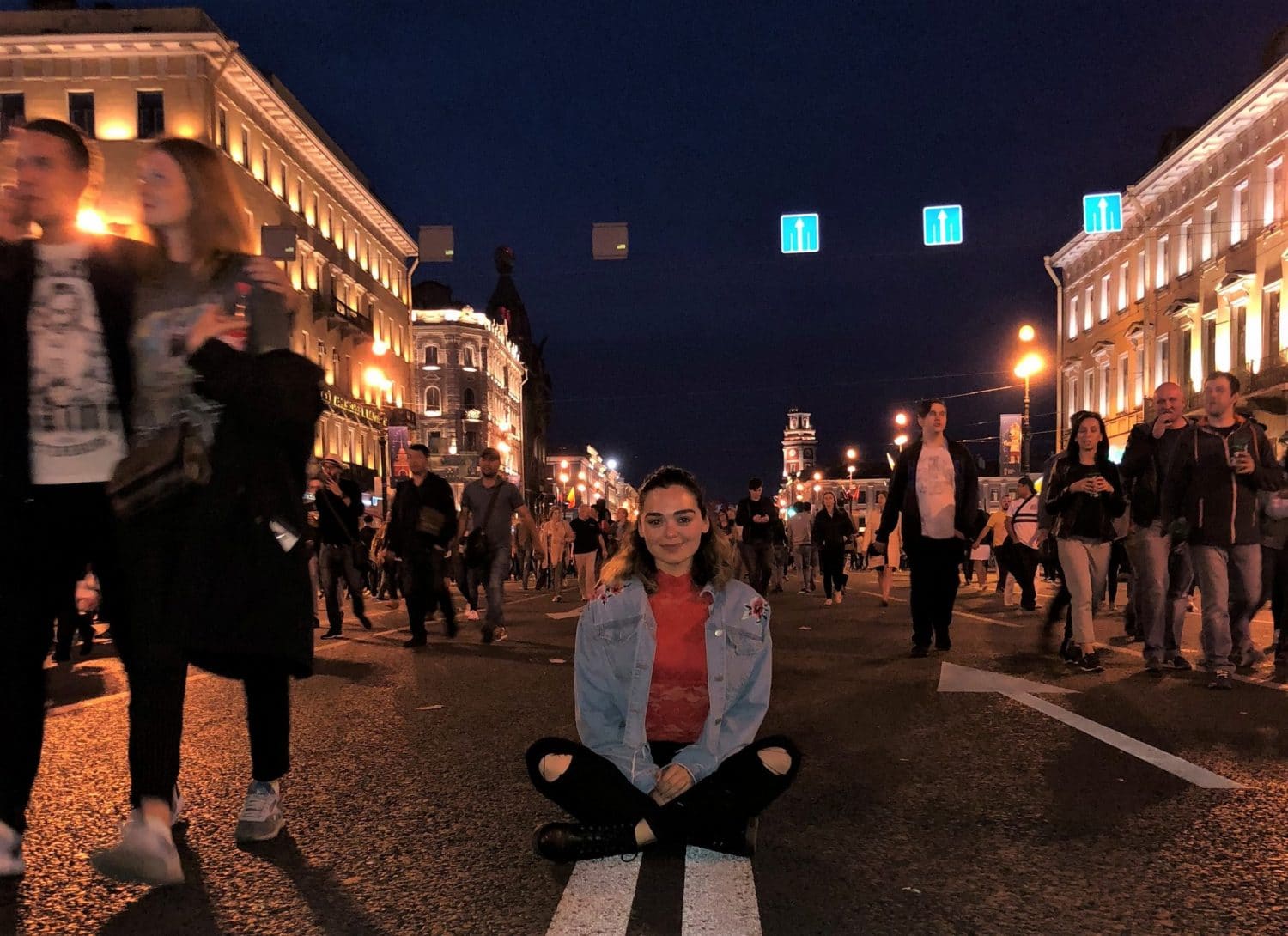
An Armenian Abroad: Adjusting to Life in St. Petersburg
Studying abroad in Russia as an Armenian American was eye-opening. I am a Russian Studies major that has always been interested in Russian culture and history – which are deeply intertwined with Armenian culture and history. After a summer abroad, viewing life in St. Petersburg through an Armenian-American lens, I feel that I have come […]
More Phrasebooks
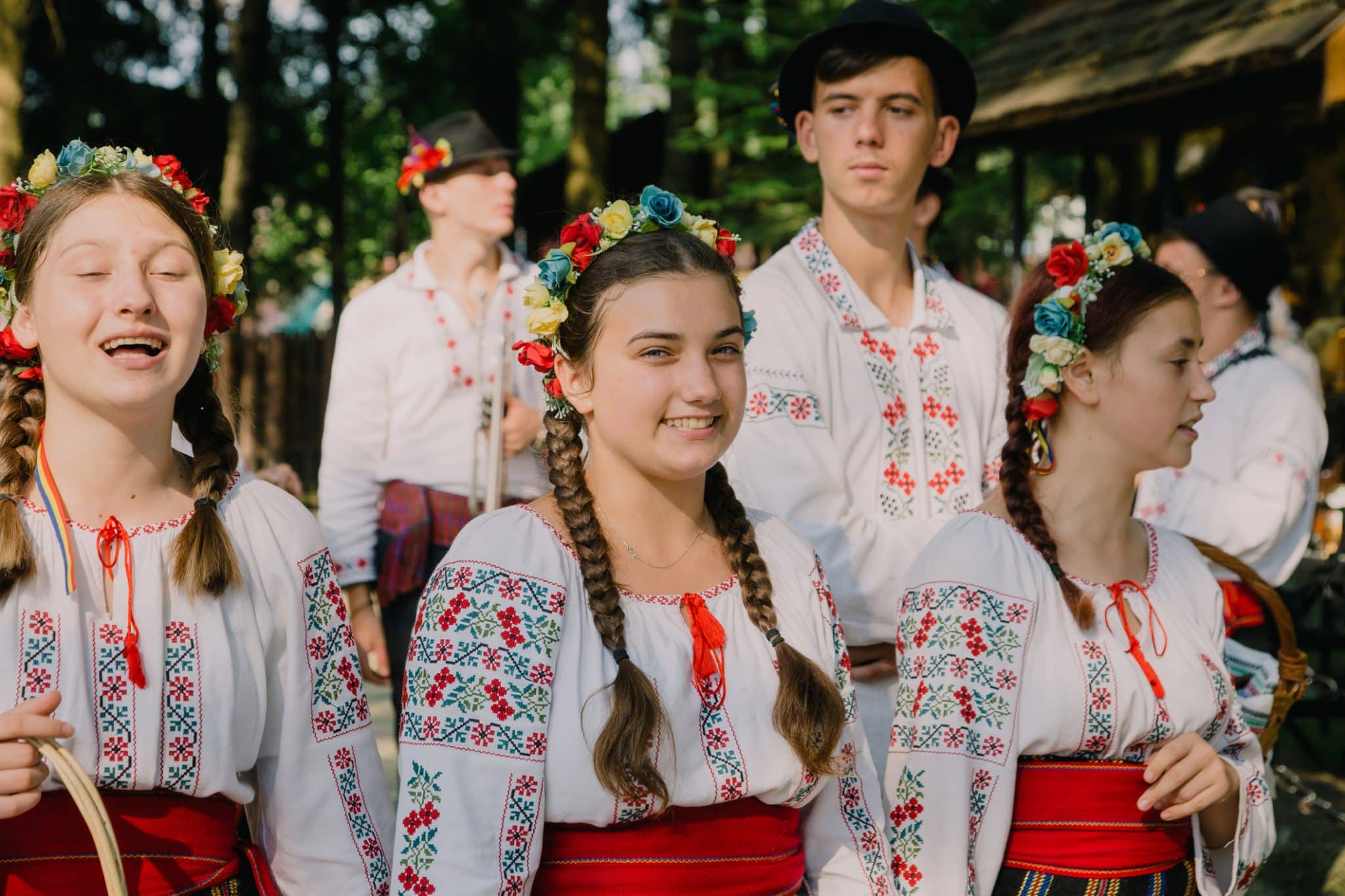
The Talking Romanian (in Moldova) Phrasebook
The Talking Phrasebook Series presents useful phrases and words in side-by-side translation and with audio files specifically geared to help students work on listening skills and pronunciation. Below, you will find several useful phrases and words. To the left is the English and to the far right is the Romanian translation. In the center column […]

The Talking Turkish Phrasebook
The Talking Phrasebook Series presents useful phrases and words in side-by-side translation and with audio files specifically geared to help students work on listening skills and pronunciation. Below, you will find several useful phrases and words. To the left is the English and to the far right is the Turkish translation. In the center column for […]
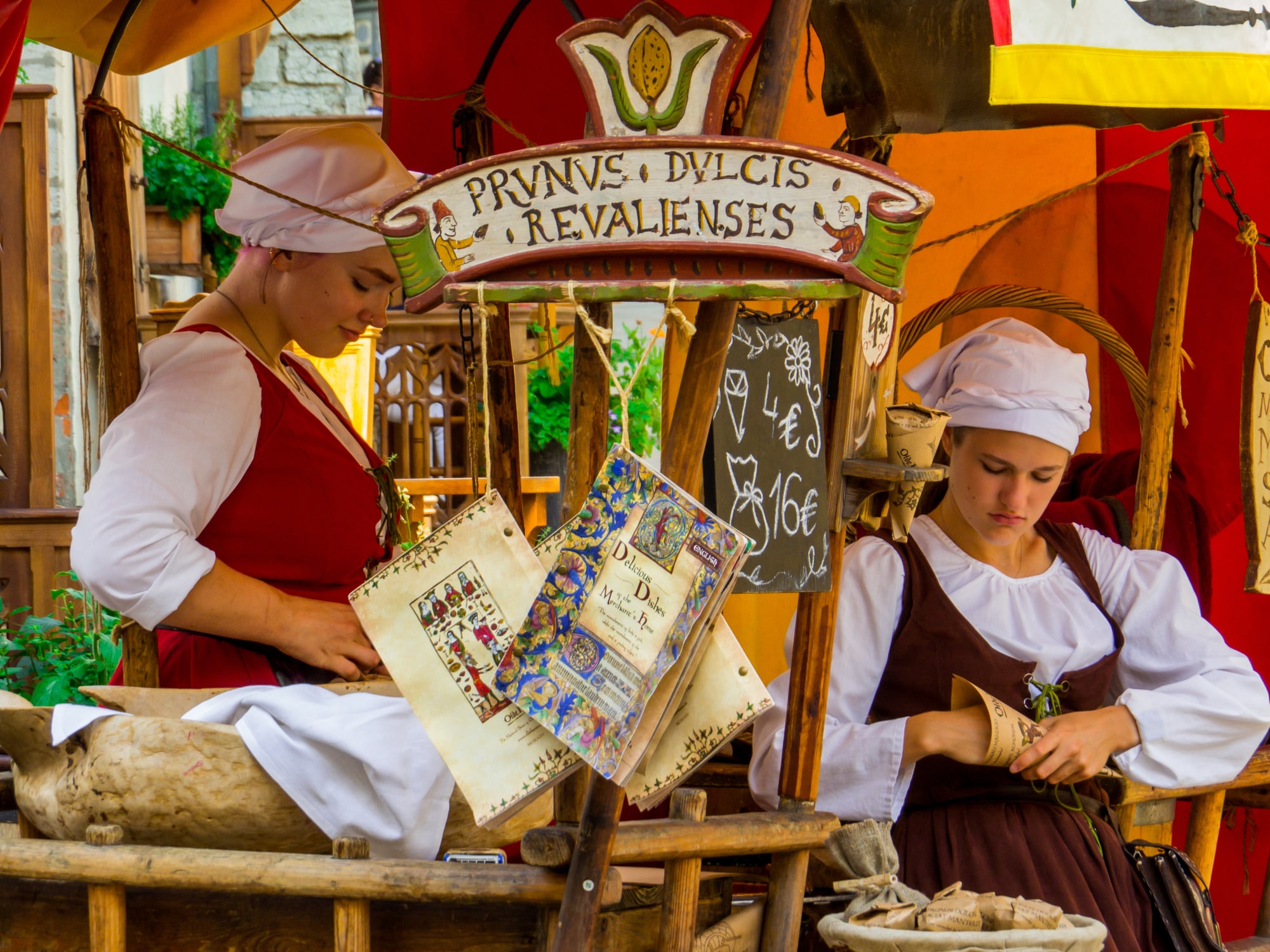
The Talking Estonian Phrasebook
The Talking Phrasebook Series presents useful phrases and words in side-by-side translation and with audio files specifically geared to help students work on listening skills and pronunciation. Below, you will find several useful phrases and words. To the left is the English and to the far right is the Estonian translation. In the center column […]





